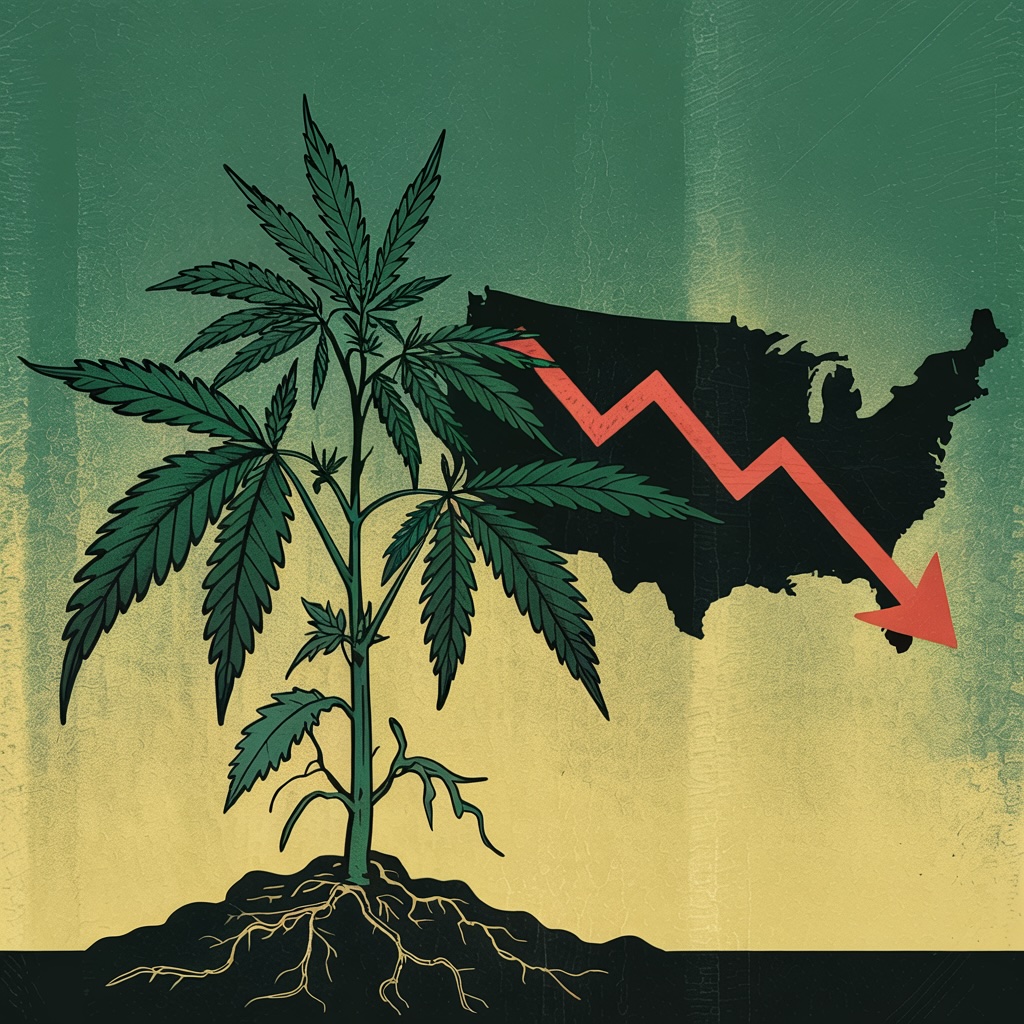Once the fertile crescent of American weed, Humboldt now signals a national cannabis market in crisis—threatened by rising costs, corporate consolidation, and vanishing craft growers.
For decades, Humboldt County stood as the heartbeat of American cannabis cultivation. Cradled in California’s Emerald Triangle, its legacy sprouted from countercultural movements in the 1960s and ’70s, when back-to-the-landers began growing cannabis as both resistance and livelihood.
Over time, that outlaw experimentation evolved into world-class cultivation, pioneering techniques and genetics that shaped the modern cannabis market. “Humboldt-grown” became shorthand for quality—an organic brand rooted in rebellion and botanical excellence.
Then came Proposition 64. When California legalized recreational cannabis in 2016, Humboldt’s generational growers saw a chance to shed their gray-market existence and step into legitimacy. They applied for licenses, paid taxes, installed security systems, adopted track-and-trace tech, and bent tradition to meet regulation. However, the state’s version of legalization wasn’t designed for them. It favored capital, scale, and corporate logistics. The result? A slow-motion collapse of the very region that built the industry in the first place.
And as Humboldt goes, so goes the industry.
The National Squeeze: High Costs, Low Prices
Growers across the country are feeling the same squeeze that’s choking Humboldt. Inflation-related rises in cultivation are up 20 to 30 percent for basic inputs like soil, nutrients, and irrigation gear. Labor expenses are up 15 percent year-over-year, and electricity bills for indoor grows continue to spike amid volatile energy markets.
At the same time, wholesale cannabis prices are falling. Oversaturation in legal markets has led to steep declines in flower prices—some regions report drops as high as $500 per pound. It’s a brutal paradox: production costs go up while revenue goes down. And small farmers, already operating on razor-thin margins, are the first to fall.
The economic chokehold tightened further on April 2, 2025, when President Donald Trump announced a sweeping increase in reciprocal tariffs—up 34 percent on Chinese imports, now totaling 54 percent. A 10 percent baseline tariff on all countries was also proposed.
For cannabis operators, this is more than a political flashpoint. It’s a financial landmine. From LED lighting and climate control equipment to vape cartridges and packaging materials, virtually every imported component of cannabis production is now more expensive. Even a two- or three-cent increase per unit adds up when thousands are sold each month. Those costs eventually hit the shelf—or the grower’s already depleted bottom line.
Humboldt’s Unraveling: A Legacy in Peril
If the national cannabis market is cracking, Humboldt is where the rupture begins.
The once-booming region is now riddled with abandoned farms and properties converted to non-cannabis uses. In 2023, over 60 percent of Humboldt growers reported financial losses, with many defaulting on loans or selling their land. The local economy, once buoyed by cannabis dollars, is spiraling. Businesses that serviced the cultivation sector—irrigation companies, equipment suppliers, trimming crews—are watching revenues evaporate.
One of the region’s most punishing burdens was Measure S, a canopy tax that charged farmers for growing space, not profits. Even if no product made it to market, the tax came due. Though repealed in 2022, the damage was already baked into Humboldt’s financial soil. And statewide, like the rest of the nation, the cost of compliance remains staggering. Licensing fees, mandatory lab testing, track-and-trace software, environmental reviews—together, these consume as much as 40 percent of a small farm’s income.
The result isn’t just economic attrition. It’s cultural extinction. Humboldt’s growers aren’t faceless entrepreneurs—they’re families. Many learned to farm from their parents or grandparents, and their methods are as much folk tradition as agricultural practice. As they exit the market, they take with them knowledge, terroir, and an ethos that cannot be replicated by corporate mega-farms.
The National Parallel: A Pattern Emerges
Humboldt is not an anomaly—it’s a prototype. In Michigan, Oregon, Massachusetts, and beyond, small cultivators face the same gauntlet: rising costs, falling prices, tax traps, and regulatory overload. Colorado has seen a 34 percent decline in licensed cultivators since 2018. In California, an estimated 22 percent of cannabis sales still occur underground, as desperate farmers retreat to the only model that keeps them solvent.
This shift threatens not only legal tax revenue and public safety, but also the unique diversity that once defined American cannabis. From the citrus-heavy profiles of Mendocino to the pine-and-diesel funk of Colorado’s Western Slope, regional identity in cannabis is real—and rapidly vanishing. As consolidation accelerates, the plant becomes monocultured and commodified, with flavor, history, and ecology traded in for shelf stability and scale.
Dr. Dominic Corva, Director of the Cannabis Studies program at Cal Poly Humboldt, is leading a state-funded effort to preserve that endangered diversity. His team is cataloging and documenting legacy cannabis genetics and practices across California—a nod to the urgent need to protect what’s left before it disappears entirely.
What the Cannabis Market Needs Now
The cannabis market doesn’t need tweaks. It needs transformation.
At the federal level, descheduling cannabis is long overdue. Legal access to banking, tax deductions, and interstate commerce would free cultivators from artificial constraints that cripple their competitiveness. According to industry estimates, federal reform could save cannabis businesses over $1.2 billion annually.
Tariff relief is another urgent fix. Reducing duties on cultivation equipment, processing materials, and compliant packaging would offer immediate cost savings for U.S. operators navigating global inflation and domestic stagnation.
At the state level, policies should shift from extraction to preservation. California can lead by expanding grant programs like New York’s Cannabis Farmer Fund, streamlining permitting, and revising tax structures that punish small-scale operators. Publicly funded marketing support, cannabis tourism initiatives, and protected designations—akin to wine’s appellation systems—could preserve Humboldt’s brand and prevent fraud.
Growers, too, can pivot. Many in Humboldt are already exploring value-added products—specialized extracts, solventless concentrates, and boutique edibles that command higher margins and require less raw material. Others are leveraging Humboldt’s deep cultivation heritage for cannabis education, tourism, and research.
The Role of the Conscious Consumer
Consumers are not passive participants in this story. Their choices shape the market as much as legislation.
By choosing small-batch, transparently sourced cannabis, consumers can keep independent farms alive. “Farm-to-bowl” branding, protected geographical indications, and third-party certifications could all help demystify the source and process behind products. As Catalyst BC’s Leif Olsen puts it: “People are willing to spend money on products that offer real value beyond just getting high. They care about flavor, aroma, and all those unique things that proper cannabis embodies.”
This is about more than buzzwords. It’s about aligning purchases with values—craft over mass production, sustainability over scalability, roots over profit margins.
Humboldt Is the Future—If We Let It Be
Humboldt County was the proving ground for cannabis cultivation in America. Its collapse isn’t just a regional failure—it’s a national warning. If regulation continues to favor corporations over communities, efficiency over ecology, and compliance over culture, then Humboldt’s fate will become the blueprint for the entire American cannabis market.
But it doesn’t have to end that way.
There is still time to shift course, but it requires action—federal policy changes, state-level relief, institutional preservation, and consumer awareness. Because if Humboldt falls completely, we lose more than an industry—we lose a living archive of cannabis culture, innovation, and resistance.
And once that’s gone, no amount of lobbying or labeling will bring it back.

***
Trap Culture is the ultimate destination for cannabis enthusiasts who want to experience the best of Arizona’s cannabis culture. Whether you are looking for the hottest cannabis-friendly events, the latest news on cannabis legalization, trends in the industry and exclusive, limited-edition products from the top brands in the market, Trap Culture has you covered. Visit our website to learn more about our events, our blog, and our store. Follow us on social media to stay updated on the latest news and promotions. Join the Trap Culture family and experience the most immersive and engaging social cannabis events in Arizona.
Follow us on social media




